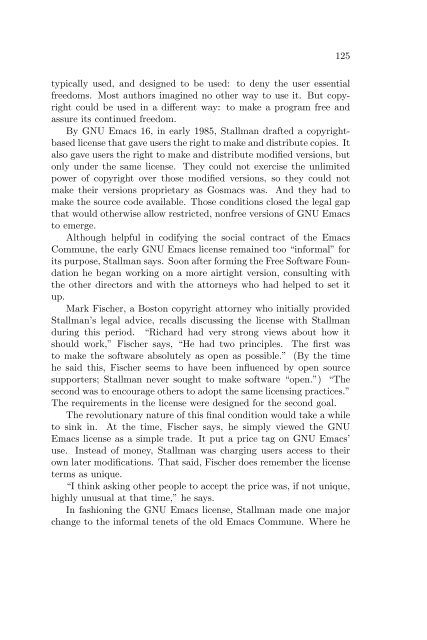Create successful ePaper yourself
Turn your PDF publications into a flip-book with our unique Google optimized e-Paper software.
125<br />
typically used, and designed to be used: to deny the user essential<br />
freedoms. Most authors imagined no other way to use it. But copyright<br />
could be used in a different way: to make a program free and<br />
assure its continued freedom.<br />
By GNU Emacs 16, in early 1985, Stallman drafted a copyrightbased<br />
license that gave users the right to make and distribute copies. It<br />
also gave users the right to make and distribute modified versions, but<br />
only under the same license. They could not exercise the unlimited<br />
power of copyright over those modified versions, so they could not<br />
make their versions proprietary as Gosmacs was. And they had to<br />
make the source code available. Those conditions closed the legal gap<br />
that would otherwise allow restricted, nonfree versions of GNU Emacs<br />
to emerge.<br />
Although helpful in codifying the social contract of the Emacs<br />
Commune, the early GNU Emacs license remained too “informal” for<br />
its purpose, Stallman says. Soon after forming the Free Software Foundation<br />
he began working on a more airtight version, consulting with<br />
the other directors and with the attorneys who had helped to set it<br />
up.<br />
Mark Fischer, a Boston copyright attorney who initially provided<br />
Stallman’s legal advice, recalls discussing the license with Stallman<br />
during this period. “Richard had very strong views about how it<br />
should work,” Fischer says, “He had two principles. The first was<br />
to make the software absolutely as open as possible.” (By the time<br />
he said this, Fischer seems to have been influenced by open source<br />
supporters; Stallman never sought to make software “open.”) “The<br />
second was to encourage others to adopt the same licensing practices.”<br />
The requirements in the license were designed for the second goal.<br />
The revolutionary nature of this final condition would take a while<br />
to sink in. At the time, Fischer says, he simply viewed the GNU<br />
Emacs license as a simple trade. It put a price tag on GNU Emacs’<br />
use. Instead of money, Stallman was charging users access to their<br />
own later modifications. That said, Fischer does remember the license<br />
terms as unique.<br />
“I think asking other people to accept the price was, if not unique,<br />
highly unusual at that time,” he says.<br />
In fashioning the GNU Emacs license, Stallman made one major<br />
change to the informal tenets of the old Emacs Commune. Where he


